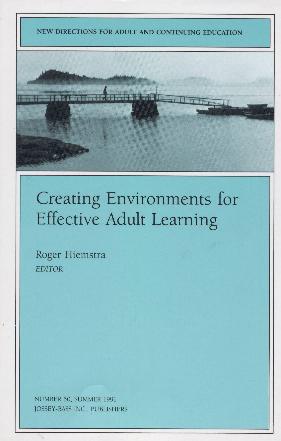

Roger Hiemstra (Editor)
New Directions for Adult and Continuing Education
Number 50, Summer 1991
Ralph B. Brockett, University of Tennessee, Knoxville, EDITOR-IN-CHIEF
Alan B. Knox, University of Wisconsin, Madison, CONSULTING EDITOR
JOSSEY-BASS INC. PUBLISHERS, San Francisco
Maxwell Macmillan International Publishing Group
New York - Oxford - Singapore - Sydney - Toronto
© 1991 by Jossey-Bass Inc., Publishers. All rights reserved.
No part of this issue may be reproduced in any form--except for a brief quotation (not to exceed 500 words) in a review or professional work--without permission in writing from the publishers.
Microfilm copies of issues and articles are available in 16mm and 35mm, as well as microfiche in 105 mm, through University Microfilms Inc., 300 North Zeeb Road, Ann Arbor, Michigan 48106
LC 85-644750 ISSN 0195-2242 ISBN 1-55542-784-7
NEW DIRECTIONS FOR ADULT AND CONTINUING EDUCATION is part of the Jossey-Bass Higher and Adult Education Series and is published quarterly by Jossey-Bass Inc., Publishers, 350 Sansome Street, San Francisco, California 94104-1310 (publication number USPS 493-930). Second-class postage paid at San Francisco, California, and at additional mailing offices.
Subscriptions for 1991 cost $45.00 for individuals and $60.00 for institutions, agencies, and libraries.
Editorial Correspondence should be sent to the Editor-in-Chief, Ralph G. Brockett, Dept. of Technological and Adult Education, University of Tennessee, 402 Claxton Addition, Knoxville, Tennessee 37996-3400.
Cover photograph by Wernher Krutein/PHOTOVAULT ©1990.
As this book is now out of print, permission to reproduce this sourcebook on this web site for use by Elmira College graduate students was granted via a letter dated April 27, 2001, reference #: 4809 ee. This material is used by permission of Jossey-Bass, Inc., a subsidiary of John Wiley & Sons, Inc.
ISBN 1-55542-255-1
Contents
Editor's Notes (Roger Hiemstra)
1. Aspects of Effective Learning Environments (Roger Hiemstra)
An exploration of various meanings of learning environments establishes a framework for this volume that is built around physical, psychological-emotional, and sociocultural categories.
2. A Conceptual Model for Understanding the Physical Attributes of Learning Environments (Rodney D. Fulton)
The model SPATIAL provides a framework for addressing the complex relationships between physical setting and learning activities by allowing for an interaction among several variables.
3. Where We Learn Shapes Our Learning (Richard S. Vosko)
The way adult educators and adult learners arrange or manipulate the physical environment can affect associated learning experiences.
4. Incorporating Microcomputer Technology into Adult Learning Environments (Judith K. DeJoy)
The use of microcomputer technology with adult learners requires that adult educators understand the relationship of emotions, perceptions, and self-concepts to the learning process.
5. Setting the Climate for Effective Teaching and Learning (Burton R. Sisco)
The importance of the first few hours spent by a teacher with learners and what can be done to enhance the learning climate are described.
6. Adverse Baggage in the Learning Environment (V. L. Mike Mahoney)
Various internal and external situations, problems, and barriers are faced each day by adult learners, any of which can affect their abilities to participate in learning experiences.
7. Perceptual Patterns and the Learning Environment: Confronting White Racism (Scipio A. J. Colin III, Trudie Kibbe Preciphs)
Racism must be confronted if all learners are to have equal access to effective learning environments.
8. Women's Trouble: Women, Gender, and the Learning Environment (Susan Collard, Joyce Stalker)
Oppression and exploitation of women persist in the adult education field; thus a new commitment to women learners is required to counteract and neutralize sexism in adult education.
9. Resources on Adult Learning Environments (Rodney D. Fulton, Roger Hiemstra)
Selected books, book chapters, monographs, and journal articles, associated with the learning environment in general or with specific ideas presented in this volume, are annotated.
10. Toward Building More Effective Learning Environments (Roger Hiemstra)
Various themes from previous chapters and ideas for future research on learning environments are summarized.
May, 2001
 -- Return to Roger Hiemstra's opening page
-- Return to Roger Hiemstra's opening page
 -- Go to
Editor's Notes,
Chapter One,
Chapter Two,
Chapter Three,
Chapter Four,
Chapter Five,
Chapter Six,
Chapter Seven,
Chapter Eight,
Chapter Nine,
Chapter Ten, or
The Index.
-- Go to
Editor's Notes,
Chapter One,
Chapter Two,
Chapter Three,
Chapter Four,
Chapter Five,
Chapter Six,
Chapter Seven,
Chapter Eight,
Chapter Nine,
Chapter Ten, or
The Index.